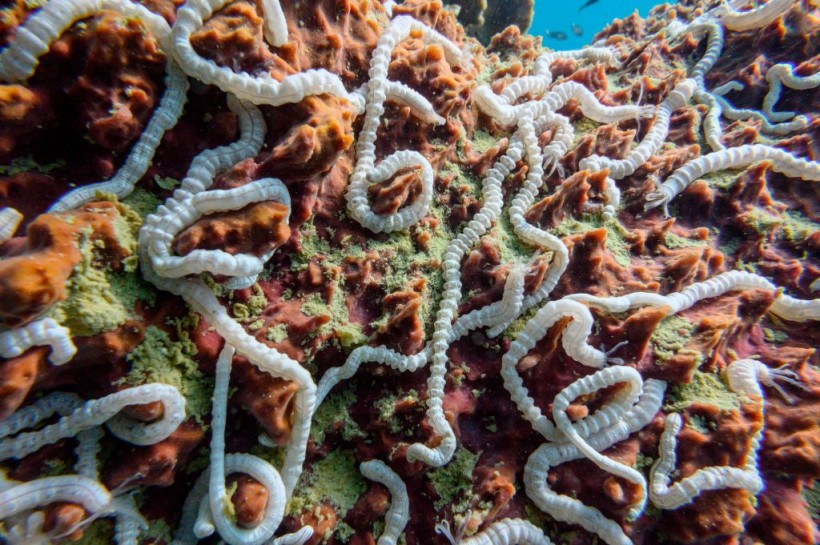A bizarre sight greeted beachgoers in Rio Grande, Argentina, as thousands of 10-inch "penis fish" washed up on the shore after heavy storms.
The creatures, which are actually a type of marine worm called urechis unicinctus, earned their nickname for their fleshy, cylindrical shape and pinkish color.
The worms normally live in burrows in the sand or mud, but were dislodged by the strong waves and currents.
Some fishermen took advantage of the rare phenomenon and collected the worms, which are considered a delicacy in some Asian countries.
What are 'penis fish' and why do they look like that?
 (Photo : ROMEO GACAD/AFP via Getty Images)
(Photo : ROMEO GACAD/AFP via Getty Images)

Penis fish are not fish at all, but a species of spoon worm, a group of marine animals that belong to the phylum Echiura, as per Daily Mail.
They have a soft, elongated body that can contract and expand, and a short proboscis, or snout, that they use to feed on organic matter and microorganisms in the sediment.
They have no eyes, no mouth, no anus, and no respiratory or circulatory system. They breathe through their skin and excrete waste through their proboscis.
The worms can grow up to 30 centometers (12 inches) long and two centimeters (0.8 inches) wide, and have a lifespan of up to 25 years.
They are found in temperate and tropical waters around the world, especially in the Pacific and Indian Oceans.
They are also known as fat innkeeper worms, because they create U-shaped burrows in the sand or mud that provide shelter for other animals, such as crabs, clams, and fish.
The worms have a simple reproductive system that consists of a single gonad that produces both eggs and sperm. They are hermaphrodites, meaning they have both male and female sex organs, but they cannot self-fertilize.
They reproduce by releasing their gametes into the water, where they meet and form larvae that settle on the seafloor and grow into adults.
The reason why the worms look like penises is not clear, but it may be related to their burrowing lifestyle and their need to conserve water.
Their cylindrical shape may help them move through the sediment more easily and avoid predators.
Their pinkish color may be due to the presence of hemoglobin, a protein that carries oxygen in the blood of many animals.
Hemoglobin may help the worms survive in low-oxygen environments and also protect them from UV radiation.
Also Read: Scientists Find Bizarre Penis-Shaped Creature From Australia's Depths
How are 'penis fish' used by humans?
The penis fish is not only curious-looking creatures, but also valuable sources of food and medicine for humans. In some Asian countries, such as China, Korea, Japan, and Vietnam, they are considered a delicacy and eaten raw, cooked, or dried, as per the BBC.
They are said to have a chewy texture and a salty flavor, and are believed to have aphrodisiac properties.
In Korea, the worms are called gaebul, which means "dog penis", and are sold in seafood markets or served in restaurants. They are usually cut into pieces and seasoned with salt, sesame oil, vinegar, and gochujang (red pepper paste). They can also be grilled or stir-fried with vegetables.
In China, the worms are called haichang or haimaogongzi, which mean "sea intestine" or "sea cat prince," respectively.
They are often eaten raw with vinegar or soy sauce, or cooked in soups or stews. They are also used in traditional medicine to treat various ailments, such as impotence, arthritis, asthma, and anemia.
In Japan, the worms are called umiushi or umimushi, which mean "sea cow" or "sea insect," respectively. They are usually boiled or steamed with salt or soy sauce, or pickled with vinegar or sake. They are also used as bait for fishing.
In Vietnam, the worms are called rươi, which means "worms." They are often fried with garlic, onions, and spices, or made into patties with rice flour and eggs. They are also used as fertilizer for crops.
The worms are not only consumed by humans, but also by other animals, such as birds, fish, sharks, and otters. They are an important part of the marine food web and play a role in nutrient cycling and sediment stabilization.
However, the worms are also threatened by overharvesting, pollution, habitat loss, and climate change. Their populations have declined in some areas due to human activities and natural disasters.
They need to be protected and managed sustainably to ensure their survival and their benefits for humans and the environment.
Related article: Penis-Shaped Worm Creature Solves Ancient Fossil Mystery
© 2024 NatureWorldNews.com All rights reserved. Do not reproduce without permission.




![Climate Change is Reducing Dust Levels Worldwide as Arctic Temperature Warms [Study]](https://1471793142.rsc.cdn77.org/data/thumbs/full/70320/280/157/50/40/climate-change-is-reducing-dust-levels-worldwide-as-arctic-temperature-warms-study.jpg)
